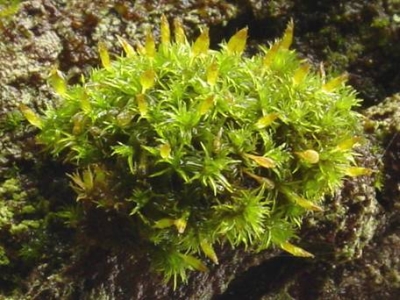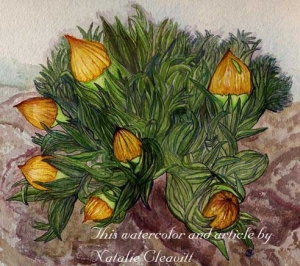Ulota and Orthotrichum – the tree cushion mosses
Ulota and Orthotrichum are two moss genera commonly found as epiphytes (epi = upon, phyte = plant) on hardwood trees in our area. These two genera are closely related and both are members of the family Orthotrichaceae. They can be seen throughout the winter in their cheerful green cushions often sporting sporophytes with beautiful hats. These “hats” called calyptrae (sing. calyptra) are the remnant of the top part of the archegonium (the ancient vessel), which held the egg that was fertilized to produce the sporophyte. The sporophyte has several other parts including the long stalk called a seta and the spore case (sporangium) often called a capsule.
In this sketch of Orthotrichum speciosum adapted from Draper et al. (2003), several sporophyte characters discussed in the article are labeled: a. hairy calyptra, b. seta (plural setae), c. capsule without ribs and d. capsule with ribs visible as darker stripes.The most common member of the family in the area is in the genus Ulota - Ulota crispa (see photo). As the species name implies, the leaves on this moss are crisped, that is, curled inward and around one another when the plants are dry. On old sugar maples, you may also see Ulota coarctata with longer setae and more puckered, smooth capsules than U. crispa. The crisped leaf habit of these two species of Ulota contrasts with Orthotrichum which has straighter (erect) leaves wet or dry. Another difference between Ulota and Orthotrichum is that Ulota capsules are always exserted beyond the upper leaves, while in species of Orthotrichum the capsules are often partly hidden by the upper leaves. If you have a hand lens, you might also look at the shape of the leaves on your moss cushion. The leaves of Ulota are longer and more linear, while those of Orthotrichum tend to round outward in the middle and back up to the tip giving Orthotrichum stems a chubbier look.
There are several common species of Orthotrichum in the area including O. pusillum (illustrated here). Many microscopic features are generally used to distinguish between species of Orthotrichum, but here I attempted to make a field key to species of Orthotrichum that you are likely to see on hardwood trees in the Finger Lakes region. Please give it a try and let me know what you find!
Field Key to Orthotrichum species of the Finger Lakes region, NY
1 Stems of plants robust, and to several cm tall...................................2
1 Stems of plants small to medium, equal to or less than 1cm tall............3
2 Capsules 2-3x’s as long as wide and indistinctly ribbed (stripes), ribs only discernable near mouth of capsule .............O. speciosum
2 Capsule shorter and strongly ribbed, dark brown stripes apparent for length of the capsule............................................O. sordidum
3 Capsules usually absent, leaves with broadly rounded tips and brown pill-shaped gemmae visible with a hand lens on the inner leaf surface........O. obtusifolium
3 Capsules present, leaves with pointed tips and no gemmae.....................4
4 Stems of plants medium, 6-10mm high, calyptra hairy..............................5
4 Stems of plants small, 2-5mm high, calyptra smooth to sparsely hairy..........6
5 Capsules with ribs spaced apart along the length of the capsule, capsule not narrowed to the mouth, calyptra sparsely hairy...........................O. ohioense
5 Capsules with distinct ribs that approach one another below the mouth of the capsule, calyptra very hairy (pilose).........................................O. sordidum
6 Capsules delicate, not ribbed, light-colored, yellow-tan...........................O. pusillum
6 Capsules strongly ribbed, dark brown with age.........................................7
7 Yellow-brown plants, 3-5mm tall, leaves with acute tip, entire, capsules strongly ribbed (dark stripes) constricting the capsule so that it narrows and the ribs;touch below the mouth when dry (strangulate)...................................O. stellatum
7 Dark brownish plants, 2-3mm tall, leaves around capsule with sharply pointed and toothed tips, capsule somewhat narrowed but not strangulate......O. pumilum
This key benefited from comments by Sue Williams and was constructed with reference to Crum and Anderson (1981).
References cited:
Crum, HA and LE Anderson.1981.Mosses of eastern North America, volume 2. Columbia University Press.
Draper, I, F Lara, B Albertos, R Garilett and V Mazimpaka. 2003. "The epiphytic bryoflora of the Jbel Bouhalla (Rif, Morocco), including a new variety of moss, Orthotrichum speciosum var. brevisetum". Journal of Bryology 25:271-280.
About
By Nat Cleavitt
Photos by F. Robert Wesley, drawings by Nat Cleavitt





